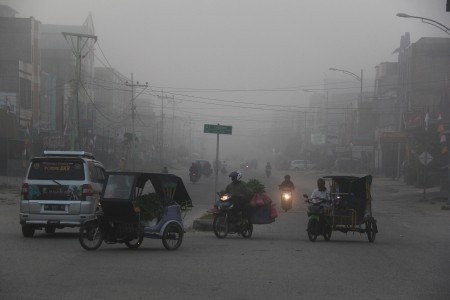Indonesia braces for wildfires ahead of El Niño

Credit to Author: lalos| Date: Mon, 25 Feb 2019 08:26:41 +0000
JAKARTA — The Indonesian government has declared 16 provinces across the country as prone to forest and land fires ahead of the upcoming El Niño, a climate pattern linked to warming waters in the central and eastern areas of the equatorial Pacific Ocean.
Such weather phenomena are known to trigger an extension of the dry season in Indonesia, which can increase the risk of wildfire.
An official with the Office of the Coordinating Political, Legal and Security Affairs Minister, Bambang Sugeng, said the emergency declaration that certain areas were wildfire-prone was done as a warning for these regions to stay alert to prevent forest and land fires.
“We are prioritizing some provinces, such as South Sumatra, Jambi, Aceh and Riau,” Bambang said after a coordination meeting in South Sumatra recently. He added that most of these regions had vast areas of peat land that could easily burn during the dry season.
Four additional provinces have been added to the list of fire-prone areas since last year, namely Bengkulu, East Nusa Tenggara, Papua and West Papua, because agencies recorded wildfires breaking out in those regions throughout 2018.
According to a report by the United States Climate Prediction Center issued in Feb. 19, El Niño conditions were present as the equatorial sea surface temperatures were above average across most of the Pacific Ocean. Therefore, weak El Niño conditions were expected to continue through this year’s Northern Hemisphere spring.
In Indonesia, Bambang said authorities were still waiting for a report from the Meteorology, Climatology and Geophysics Agency (BMKG) on the start of the prolonged dry season because the climatic conditions of each region were different.
Riau became one of the first provinces in the country to respond to forest and land fires, as its administration declared an emergency status concerning ongoing peat land and forest fires. The status, valid from Feb. 19 to Oct. 31 this year, was issued based on the growing number of peat land and forest fires in the area, such as in Dumai, Rokan Hilir and Bengkalis.
Smokey haze created by such fires in Riau forced administrations to close schools, distribute free face masks and advise students to avoid outdoor activities. From Feb. 12 to 16, the Riau Health Agency recorded 1,081 cases of smoke-related illnesses, mostly in patients below 20 years of age.
Environment and Forestry Minister Siti Nurbaya Bakar said fire was a regular occurrence in Riau as a high number of hot spots were always detected around late February.
“Despite the regularity, we always work to take care of any detected hot spots. Once we detect a fire, we immediately extinguish it. That is our current prevention concept,” Siti told journalists recently.
She added that the authorities also asked corporations to keep peat lands in their concession from drying out, as well as to increase patrols on lands owned by other people.
The minister echoed Bambang’s wish to not let a haze disaster similar to the one in 2015 from happening.
In 2015, Sumatra and Kalimantan experienced devastating fires, with more than 1 million hectares of forests destroyed and dozens of people killed. A prolonged dry season caused by an especially strong El Niño effect was blamed for the fires. However, environmentalists and rights activists said they believe slash-and-burn land clearing for oil palm and other plantations was the real cause.
According to the US National Oceanic and Atmospheric Administration (NOAA) satellite operated by Singapore, at least 30 hot spots were detected in Riau between Jan. 1 and Feb. 19 this year. Meanwhile, two other satellites, Terra and Aqua, recorded 146 hot spots in the province in the same period.
According to a 2015 presidential instruction on handling land and forest fires, regions are required to form a task force tasked to mitigate the hazards of fire even before their administrations declare an emergency status. The task forces are to take a number of measures to prevent fires from occurring, from digging artesian wells to waterbombing dried peat land.
Meanwhile, a local military unit in South Sumatra’s Banyuasin regency is using a biochemical agent to try to prevent peat land from burning. The agent, named Bios 44, is expected to close off holes and pores on dry peat soil that make it easier for air to enter and any give fires more oxygen.
Click here for more weather related news.”